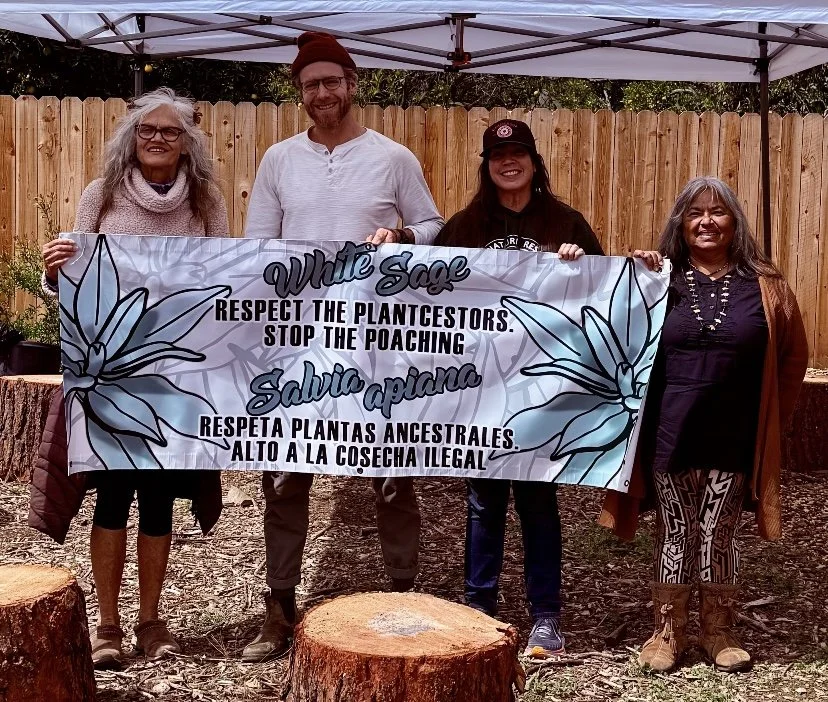Shared Visions
In collaboration with their Nature Immersion programming partner, Elena Rios, Taft Gardens’ latest initiative focuses on Salvia apiana, commonly known as white sage, through our White Sage Restoration Project.
NEWS FROM WHITE SAGE TERRITORY:
The only place in the world where White Sage/Salvia apiana is found growing in the wild is in the coastal sage scrub habitat of Central/Southern California, on down to Northern Baja California.
Burning and smudging with White Sage wands has become a global "craze".
Plant numbers in the wild are dwindling due to the poaching of it out of the wild to meet this demand.
Urban development and land-use associated with cities, roads, buildings and infrastructure is leading to habitat loss.
With very few commercial growers, the majority of White Sage products on the market, such as smudge wands, have been poached out of the wild, yet promoted as sustainable.
Poachers do not follow sustainable or traditional gathering practices.
Poachers often rip the whole plant out by the roots, leaving entire hillsides bare.
The Ecological Impact: White Sage is an important pollinator plant. It is a food source for bees, butterflies, birds, deer, rabbit and other wildlife.
The Cultural Impact: The loss of White Sage affects Native people of the Californias who have tended specific stands of White Sage as food, medicine, and more for generations.
Call to action: We believe that White Sage is in danger of becoming extinct. We recognize that the commodification of this plant for the purpose of smudging with White Sage is adding to the problem and sends the wrong message. Join a growing movement to NOT participate in the commodification of White Sage/Salvia apiana products, such as smudge wands.
Boycott the sale of White Sage/Salvia apiana
If you are a storekeeper, consider displaying materials that help educate
Work with existing organizations to help build awareness
Source White Sage/Salvia apiana from someone who is actually growing it, or knows someone who is actually (really) growing it. Do the research and make sure. Reciprocate through a kind act, trade, or pay it forward.
Grow it from seed
Grow it in a community garden
Grow it in parkways
Grow it in your garden (especially if you live in the zone where it grows in the wild anyway)
Purchase a plant from a reputable nursery or grower
Grow and incorporate it into urban landscape designs where it can thrive
Initiate restoration projects in wild spaces
Burning and smudging with a single dry leaf will support self-care practices
How badly do you really need that White Sage smudge wand? If you don’t know how it was gathered in the first place, how good is the medicine anyway?
Research your own ancestral use of other plants that may be dried and bundled as a smudge wand
Avoid creating posts on social media showing the burning of white sage smudge wands. It seems harmless, but it can appear to disregard sustainability, ethical, ecological, and cultural awareness of this plant relative.
John R. Johnson, Ph.D., has served as Curator of Anthropology at the Santa Barbara Museum of Natural History since 1986. He received his Ph.D. in anthropology at University of California, Santa Barbara in 1988. Since 2003, he has taught an annual course on California Indians at UCSB, where he holds an appointment as Adjunct Professor of Anthropology. Dr. Johnson’s written contributions include more than 100 studies regarding the cultures, history, and prehistory of California’s native peoples, especially emphasizing the Chumash Indians of the Santa Barbara region.
A native of Santa Barbara, CA, Jon Obermeyer completed an MFA in Creative Writing at UNC Greensboro. He is the author of over 40 books of poetry, short fiction and creative nonfiction, including Salsipuedes: Santa Barbara Poems and his Santa Barbara memoir It Happens That Fast. Recent work has appeared in Santa Clara Review and Santa Barbara Literary Journal, Volume 11.
Gaviota Coast Conservancy is dedicated to permanently protecting the rural character and environmental integrity of the Gaviota Coast for present and future generations.
